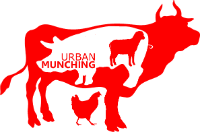Pork Crackling with Kale Coleslaw
Photo: Tim Elwin
This method of roasting pork will deliver perfect crackling every. single. time. For added success of crispiness, leave your pork belly uncovered in the fridge, skin side up for minimum 12 hours but up to 3 days.
Feeds 4 (with possibly a little leftover)
Ingredients
- 1.5kg (3.3Lb) Free Range Pork Belly, Loin or Shoulder (with skin on) If you want to brine it, check out our brine recipe
- 3 x Green Apples, cut in halves across the core
- 2 x Large Onions cut in halves across the grain
- 500ml (17oz) Chicken Stock
- 2 Cloves Garlic
- 2 Bay Leaves
- 2 Tablespoons Cup Sea Salt Flakes
- 1 Teaspoon of Olive Oil
- Coleslaw or Steamed Vegetables for serving
What You’ll Need
- A 1½ - 2 inch deep baking tray or dish
- A Kettle (min 1ltr capacity)
- A Super Sharp Knife or Retractable Blade Knife
- A Clean Kitchen Cloth/Chux, Paper Towelling or a Tea-Towel
- A Medium sized Pot
Method - Pork
Preheat oven to 250°C (480°F).
Allow the pork to come to room temperature by leaving out of the fridge for 1 hour (1½ hrs if using shoulder).
With a very sharp knife or a clean retractable blade knife (not the one from your tool box) score the pork skin in lines around ¼ inch apart (a ruler can often help keeping on track here). The other method is to cut ½ inch apart lines diagonally then ½ inch 90° in the other direction to make diamond shapes. Both will work however the straight cuts deliver a better crackle whilst also helping when carving. NOTE: you can always ask your butcher to score it for you...
Fill the kettle and boil the water. Place the pork in your (clean) sink skin side up and once the water is boiled and immediately off the boil) pour the hot water slowly over the skin ensuring you get the water into over every part of the skin. You will see the skin tighten and the pores slightly open up, this is what you want as the open pores is what will assist with the crackling. Once you have poured all the boiling water over the skin, remove the pork from the sink and pat dry with a clean kitchen cloth, paper towelling or a tea-towel, ensuring the skin is as dry as possible.
Pour the olive oil into one hand, rub your hands together then rub the oil evenly over the skin and into the cuts etc, making sure there a no pools of oil. Sprinkle liberally and evenly with sea salt, again making sure it gets into the cuts etc.
Place the cut apples and onions cut side up into the baking tray/dish then add the garlic and bay leaves. Fill the tray with enough chicken stock to cover half way up the apples and onions (around ½ inch) then place the pork on top ( i.e. the apples and onions act as a bed for the pork). If cooking pork shoulder, flatten it out as much as possible before placing on the apples etc as it will help get crackling over more of the skin.
Roast the pork on the middle shelf for 15-20 minutes until the skin starts to blister (don’t worry if it doesn’t) then turn the oven down to following temperature/time, depending on the cut of pork you are cooking;
- Pork Belly: 180°C (350°F) for 1-1½ hours
- Pork Loin: 180°C (350°F) for 1 hour
- Pork Shoulder: 150°C (300°F) for 3 hours
After the appropriate cooking time, check the skin, if there is not enough cracking then it’s time to blister the top! To do this simply turn your oven’s grill on and grill until sufficiently blistered. Be very careful here. You must continually watch it during this process as it can easily burn.
Remove from the oven and rest for 10-20mins, reserving the liquid, apples and onion from the pan.
Method - Sauce
To make the sauce, strain the liquid and squash the apples, onions and garlic through a strainer into a small to medium sized pot. Bring the liquid the boil then lower the heat to medium and reduce the sauce for 10 minutes until it is a thick syrup. By this time, the pork will have been well rested and you are ready to eat!
To serve, slice up the pork into 1cm thick pieces (or pull apart the slow cooked shoulder), lay out onto a platter and pour the sauce evenly over the top. Serve with Coleslaw or steamed vegetables.
EAT.
© Tim Elwin 2010

